Analysis of Therapeutic Communication in Nursing (NUR1102)
VerifiedAdded on 2022/09/08
|8
|2199
|19
Essay
AI Summary
This essay analyzes a nursing scenario to demonstrate the application of therapeutic communication strategies and skills. The assignment begins with an overview of therapeutic communication, emphasizing the importance of face-to-face interactions in enhancing a patient's emotional and physical well-being. It then delves into the chosen scenario, highlighting ineffective communication instances and exploring the significance of observation, broad openings, and encouraging patient illustration. The essay further discusses key strategies such as active listening and offering hope, while also addressing the importance of health literacy skills in managing challenging situations. The conclusion underscores the critical role of therapeutic communication in nursing practice, emphasizing its impact on patient outcomes and the necessity of continuous learning and skill development. The essay underscores the importance of nurses understanding the patient and family's perspectives to ensure that effective communication is established for better patient care and well-being.
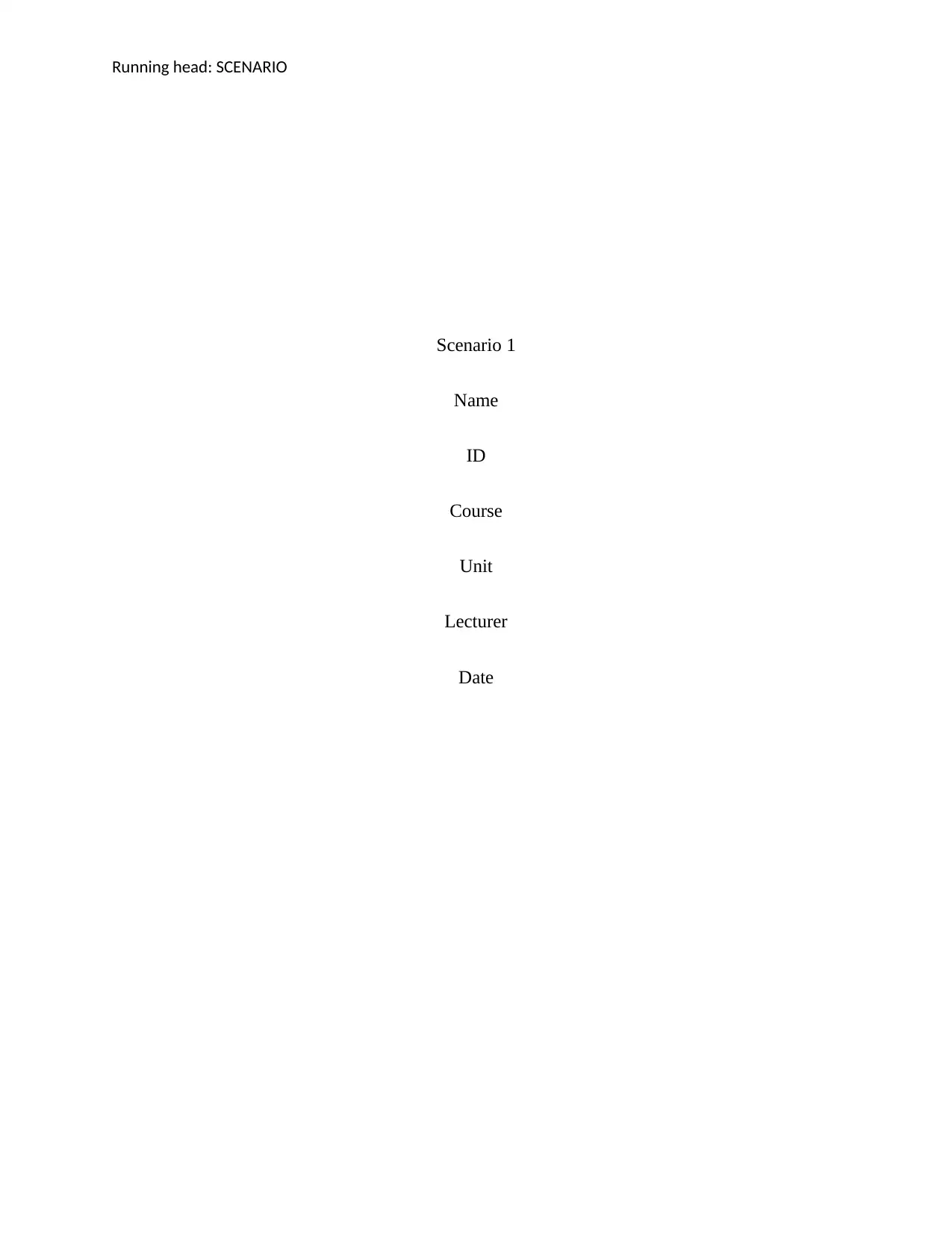
Running head: SCENARIO
Scenario 1
Name
ID
Course
Unit
Lecturer
Date
Scenario 1
Name
ID
Course
Unit
Lecturer
Date
Paraphrase This Document
Need a fresh take? Get an instant paraphrase of this document with our AI Paraphraser
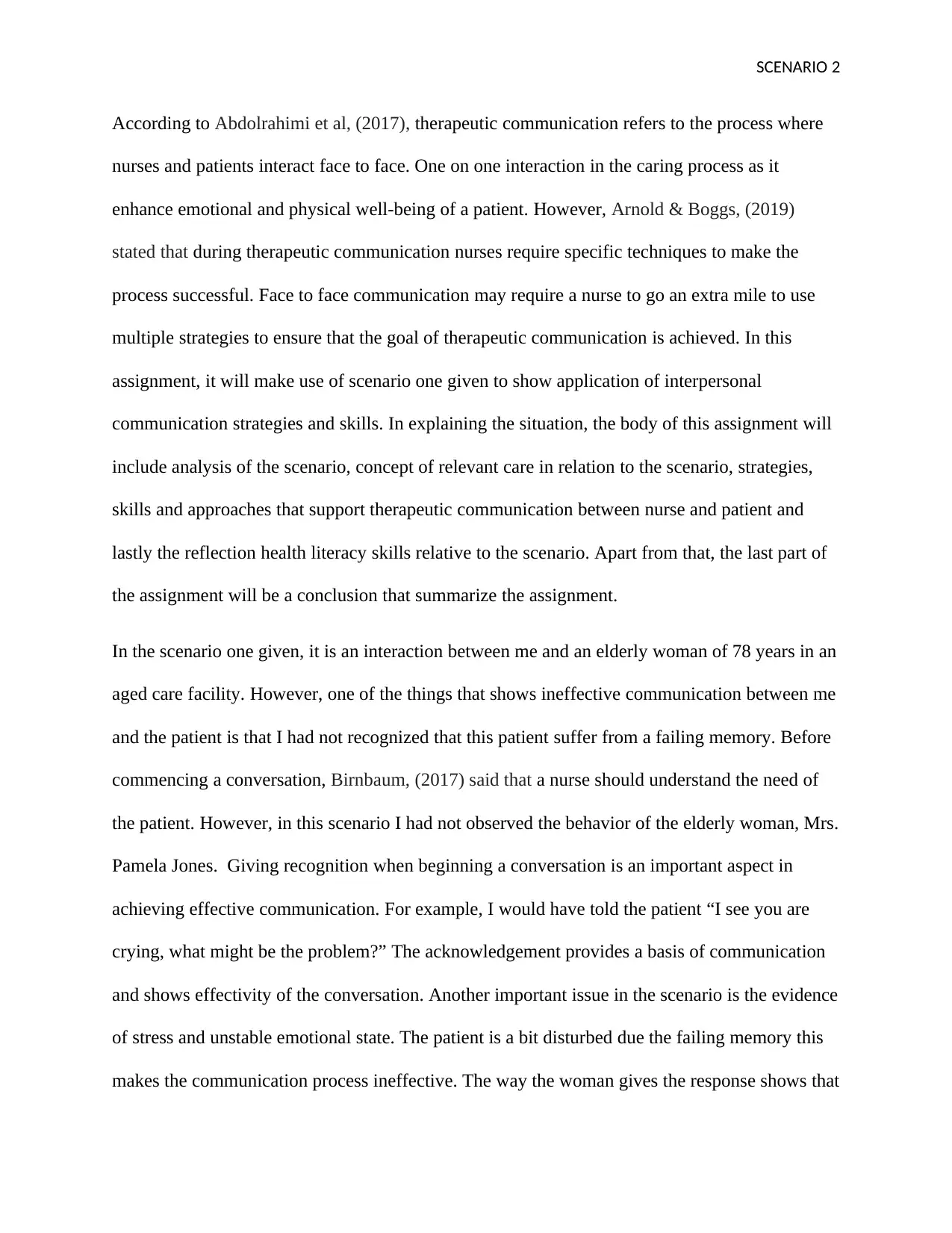
SCENARIO 2
According to Abdolrahimi et al, (2017), therapeutic communication refers to the process where
nurses and patients interact face to face. One on one interaction in the caring process as it
enhance emotional and physical well-being of a patient. However, Arnold & Boggs, (2019)
stated that during therapeutic communication nurses require specific techniques to make the
process successful. Face to face communication may require a nurse to go an extra mile to use
multiple strategies to ensure that the goal of therapeutic communication is achieved. In this
assignment, it will make use of scenario one given to show application of interpersonal
communication strategies and skills. In explaining the situation, the body of this assignment will
include analysis of the scenario, concept of relevant care in relation to the scenario, strategies,
skills and approaches that support therapeutic communication between nurse and patient and
lastly the reflection health literacy skills relative to the scenario. Apart from that, the last part of
the assignment will be a conclusion that summarize the assignment.
In the scenario one given, it is an interaction between me and an elderly woman of 78 years in an
aged care facility. However, one of the things that shows ineffective communication between me
and the patient is that I had not recognized that this patient suffer from a failing memory. Before
commencing a conversation, Birnbaum, (2017) said that a nurse should understand the need of
the patient. However, in this scenario I had not observed the behavior of the elderly woman, Mrs.
Pamela Jones. Giving recognition when beginning a conversation is an important aspect in
achieving effective communication. For example, I would have told the patient “I see you are
crying, what might be the problem?” The acknowledgement provides a basis of communication
and shows effectivity of the conversation. Another important issue in the scenario is the evidence
of stress and unstable emotional state. The patient is a bit disturbed due the failing memory this
makes the communication process ineffective. The way the woman gives the response shows that
According to Abdolrahimi et al, (2017), therapeutic communication refers to the process where
nurses and patients interact face to face. One on one interaction in the caring process as it
enhance emotional and physical well-being of a patient. However, Arnold & Boggs, (2019)
stated that during therapeutic communication nurses require specific techniques to make the
process successful. Face to face communication may require a nurse to go an extra mile to use
multiple strategies to ensure that the goal of therapeutic communication is achieved. In this
assignment, it will make use of scenario one given to show application of interpersonal
communication strategies and skills. In explaining the situation, the body of this assignment will
include analysis of the scenario, concept of relevant care in relation to the scenario, strategies,
skills and approaches that support therapeutic communication between nurse and patient and
lastly the reflection health literacy skills relative to the scenario. Apart from that, the last part of
the assignment will be a conclusion that summarize the assignment.
In the scenario one given, it is an interaction between me and an elderly woman of 78 years in an
aged care facility. However, one of the things that shows ineffective communication between me
and the patient is that I had not recognized that this patient suffer from a failing memory. Before
commencing a conversation, Birnbaum, (2017) said that a nurse should understand the need of
the patient. However, in this scenario I had not observed the behavior of the elderly woman, Mrs.
Pamela Jones. Giving recognition when beginning a conversation is an important aspect in
achieving effective communication. For example, I would have told the patient “I see you are
crying, what might be the problem?” The acknowledgement provides a basis of communication
and shows effectivity of the conversation. Another important issue in the scenario is the evidence
of stress and unstable emotional state. The patient is a bit disturbed due the failing memory this
makes the communication process ineffective. The way the woman gives the response shows that
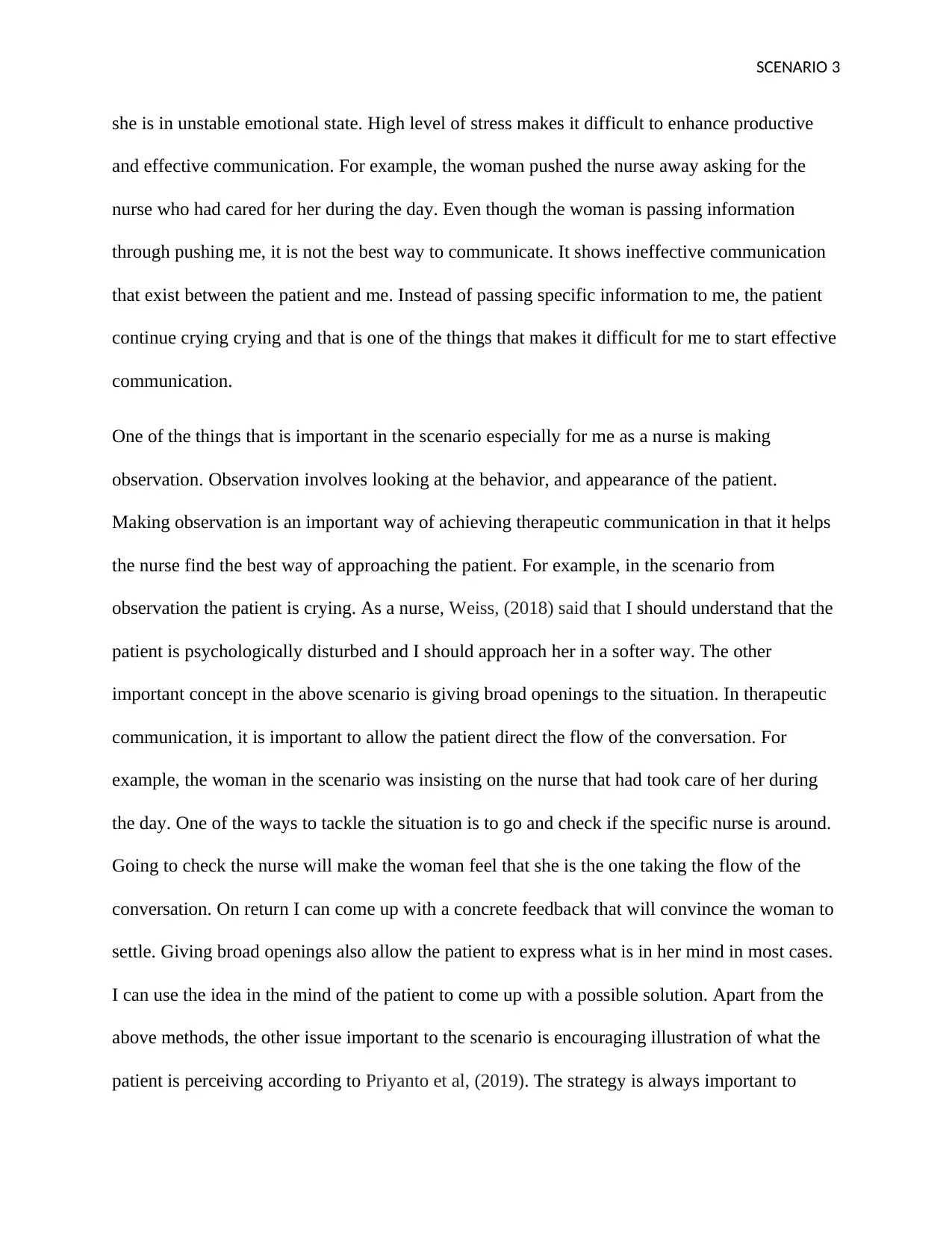
SCENARIO 3
she is in unstable emotional state. High level of stress makes it difficult to enhance productive
and effective communication. For example, the woman pushed the nurse away asking for the
nurse who had cared for her during the day. Even though the woman is passing information
through pushing me, it is not the best way to communicate. It shows ineffective communication
that exist between the patient and me. Instead of passing specific information to me, the patient
continue crying crying and that is one of the things that makes it difficult for me to start effective
communication.
One of the things that is important in the scenario especially for me as a nurse is making
observation. Observation involves looking at the behavior, and appearance of the patient.
Making observation is an important way of achieving therapeutic communication in that it helps
the nurse find the best way of approaching the patient. For example, in the scenario from
observation the patient is crying. As a nurse, Weiss, (2018) said that I should understand that the
patient is psychologically disturbed and I should approach her in a softer way. The other
important concept in the above scenario is giving broad openings to the situation. In therapeutic
communication, it is important to allow the patient direct the flow of the conversation. For
example, the woman in the scenario was insisting on the nurse that had took care of her during
the day. One of the ways to tackle the situation is to go and check if the specific nurse is around.
Going to check the nurse will make the woman feel that she is the one taking the flow of the
conversation. On return I can come up with a concrete feedback that will convince the woman to
settle. Giving broad openings also allow the patient to express what is in her mind in most cases.
I can use the idea in the mind of the patient to come up with a possible solution. Apart from the
above methods, the other issue important to the scenario is encouraging illustration of what the
patient is perceiving according to Priyanto et al, (2019). The strategy is always important to
she is in unstable emotional state. High level of stress makes it difficult to enhance productive
and effective communication. For example, the woman pushed the nurse away asking for the
nurse who had cared for her during the day. Even though the woman is passing information
through pushing me, it is not the best way to communicate. It shows ineffective communication
that exist between the patient and me. Instead of passing specific information to me, the patient
continue crying crying and that is one of the things that makes it difficult for me to start effective
communication.
One of the things that is important in the scenario especially for me as a nurse is making
observation. Observation involves looking at the behavior, and appearance of the patient.
Making observation is an important way of achieving therapeutic communication in that it helps
the nurse find the best way of approaching the patient. For example, in the scenario from
observation the patient is crying. As a nurse, Weiss, (2018) said that I should understand that the
patient is psychologically disturbed and I should approach her in a softer way. The other
important concept in the above scenario is giving broad openings to the situation. In therapeutic
communication, it is important to allow the patient direct the flow of the conversation. For
example, the woman in the scenario was insisting on the nurse that had took care of her during
the day. One of the ways to tackle the situation is to go and check if the specific nurse is around.
Going to check the nurse will make the woman feel that she is the one taking the flow of the
conversation. On return I can come up with a concrete feedback that will convince the woman to
settle. Giving broad openings also allow the patient to express what is in her mind in most cases.
I can use the idea in the mind of the patient to come up with a possible solution. Apart from the
above methods, the other issue important to the scenario is encouraging illustration of what the
patient is perceiving according to Priyanto et al, (2019). The strategy is always important to
⊘ This is a preview!⊘
Do you want full access?
Subscribe today to unlock all pages.

Trusted by 1+ million students worldwide
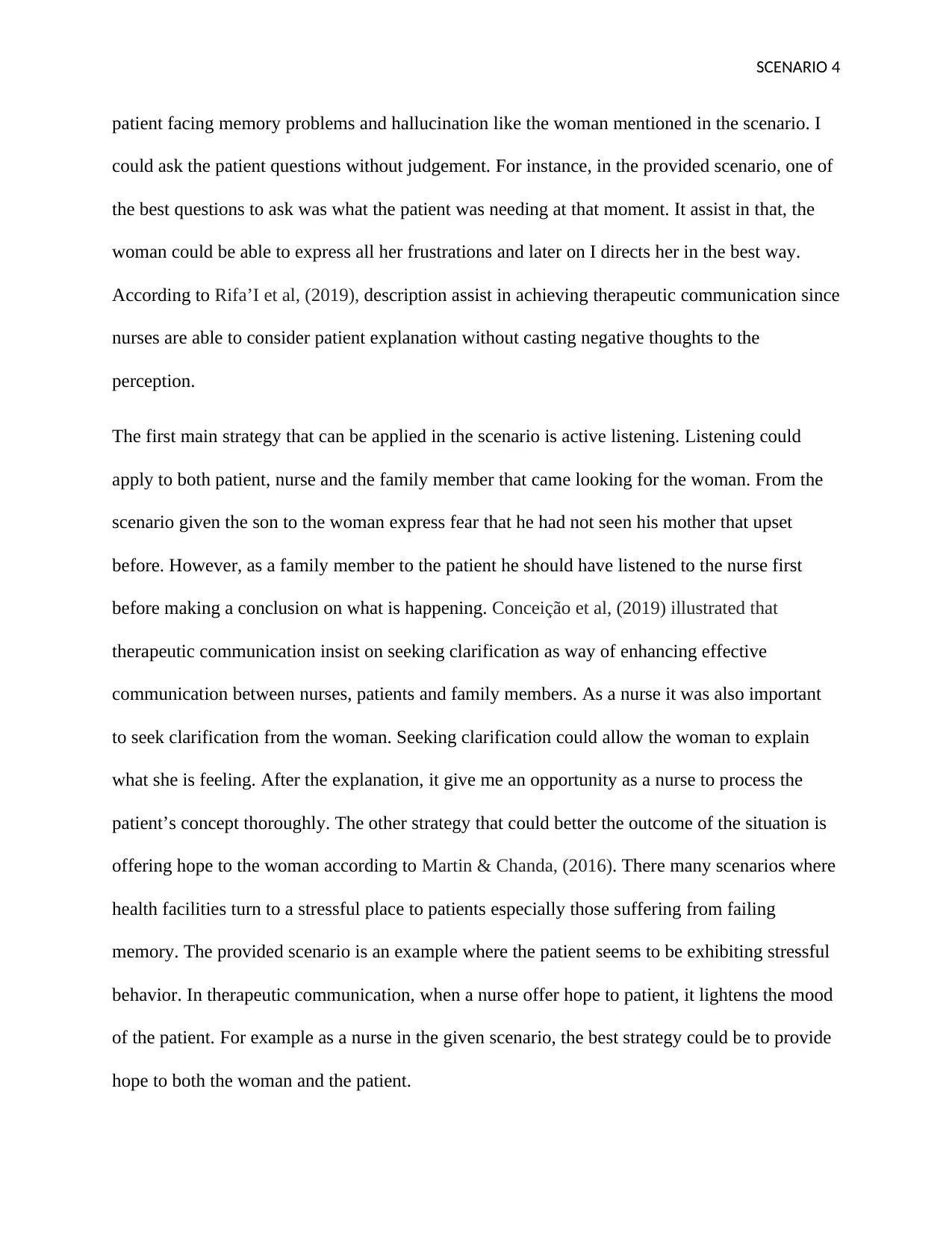
SCENARIO 4
patient facing memory problems and hallucination like the woman mentioned in the scenario. I
could ask the patient questions without judgement. For instance, in the provided scenario, one of
the best questions to ask was what the patient was needing at that moment. It assist in that, the
woman could be able to express all her frustrations and later on I directs her in the best way.
According to Rifa’I et al, (2019), description assist in achieving therapeutic communication since
nurses are able to consider patient explanation without casting negative thoughts to the
perception.
The first main strategy that can be applied in the scenario is active listening. Listening could
apply to both patient, nurse and the family member that came looking for the woman. From the
scenario given the son to the woman express fear that he had not seen his mother that upset
before. However, as a family member to the patient he should have listened to the nurse first
before making a conclusion on what is happening. Conceição et al, (2019) illustrated that
therapeutic communication insist on seeking clarification as way of enhancing effective
communication between nurses, patients and family members. As a nurse it was also important
to seek clarification from the woman. Seeking clarification could allow the woman to explain
what she is feeling. After the explanation, it give me an opportunity as a nurse to process the
patient’s concept thoroughly. The other strategy that could better the outcome of the situation is
offering hope to the woman according to Martin & Chanda, (2016). There many scenarios where
health facilities turn to a stressful place to patients especially those suffering from failing
memory. The provided scenario is an example where the patient seems to be exhibiting stressful
behavior. In therapeutic communication, when a nurse offer hope to patient, it lightens the mood
of the patient. For example as a nurse in the given scenario, the best strategy could be to provide
hope to both the woman and the patient.
patient facing memory problems and hallucination like the woman mentioned in the scenario. I
could ask the patient questions without judgement. For instance, in the provided scenario, one of
the best questions to ask was what the patient was needing at that moment. It assist in that, the
woman could be able to express all her frustrations and later on I directs her in the best way.
According to Rifa’I et al, (2019), description assist in achieving therapeutic communication since
nurses are able to consider patient explanation without casting negative thoughts to the
perception.
The first main strategy that can be applied in the scenario is active listening. Listening could
apply to both patient, nurse and the family member that came looking for the woman. From the
scenario given the son to the woman express fear that he had not seen his mother that upset
before. However, as a family member to the patient he should have listened to the nurse first
before making a conclusion on what is happening. Conceição et al, (2019) illustrated that
therapeutic communication insist on seeking clarification as way of enhancing effective
communication between nurses, patients and family members. As a nurse it was also important
to seek clarification from the woman. Seeking clarification could allow the woman to explain
what she is feeling. After the explanation, it give me an opportunity as a nurse to process the
patient’s concept thoroughly. The other strategy that could better the outcome of the situation is
offering hope to the woman according to Martin & Chanda, (2016). There many scenarios where
health facilities turn to a stressful place to patients especially those suffering from failing
memory. The provided scenario is an example where the patient seems to be exhibiting stressful
behavior. In therapeutic communication, when a nurse offer hope to patient, it lightens the mood
of the patient. For example as a nurse in the given scenario, the best strategy could be to provide
hope to both the woman and the patient.
Paraphrase This Document
Need a fresh take? Get an instant paraphrase of this document with our AI Paraphraser
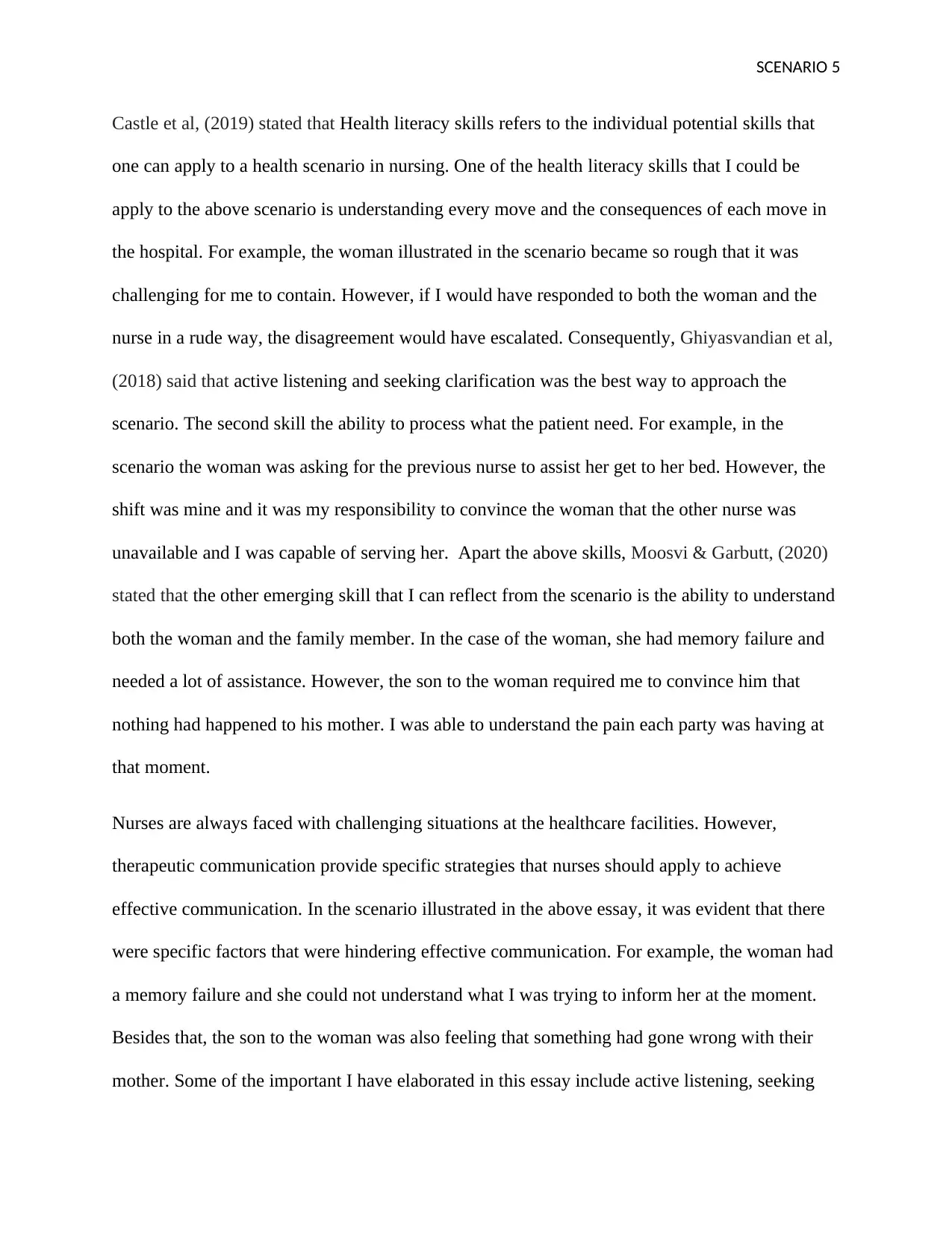
SCENARIO 5
Castle et al, (2019) stated that Health literacy skills refers to the individual potential skills that
one can apply to a health scenario in nursing. One of the health literacy skills that I could be
apply to the above scenario is understanding every move and the consequences of each move in
the hospital. For example, the woman illustrated in the scenario became so rough that it was
challenging for me to contain. However, if I would have responded to both the woman and the
nurse in a rude way, the disagreement would have escalated. Consequently, Ghiyasvandian et al,
(2018) said that active listening and seeking clarification was the best way to approach the
scenario. The second skill the ability to process what the patient need. For example, in the
scenario the woman was asking for the previous nurse to assist her get to her bed. However, the
shift was mine and it was my responsibility to convince the woman that the other nurse was
unavailable and I was capable of serving her. Apart the above skills, Moosvi & Garbutt, (2020)
stated that the other emerging skill that I can reflect from the scenario is the ability to understand
both the woman and the family member. In the case of the woman, she had memory failure and
needed a lot of assistance. However, the son to the woman required me to convince him that
nothing had happened to his mother. I was able to understand the pain each party was having at
that moment.
Nurses are always faced with challenging situations at the healthcare facilities. However,
therapeutic communication provide specific strategies that nurses should apply to achieve
effective communication. In the scenario illustrated in the above essay, it was evident that there
were specific factors that were hindering effective communication. For example, the woman had
a memory failure and she could not understand what I was trying to inform her at the moment.
Besides that, the son to the woman was also feeling that something had gone wrong with their
mother. Some of the important I have elaborated in this essay include active listening, seeking
Castle et al, (2019) stated that Health literacy skills refers to the individual potential skills that
one can apply to a health scenario in nursing. One of the health literacy skills that I could be
apply to the above scenario is understanding every move and the consequences of each move in
the hospital. For example, the woman illustrated in the scenario became so rough that it was
challenging for me to contain. However, if I would have responded to both the woman and the
nurse in a rude way, the disagreement would have escalated. Consequently, Ghiyasvandian et al,
(2018) said that active listening and seeking clarification was the best way to approach the
scenario. The second skill the ability to process what the patient need. For example, in the
scenario the woman was asking for the previous nurse to assist her get to her bed. However, the
shift was mine and it was my responsibility to convince the woman that the other nurse was
unavailable and I was capable of serving her. Apart the above skills, Moosvi & Garbutt, (2020)
stated that the other emerging skill that I can reflect from the scenario is the ability to understand
both the woman and the family member. In the case of the woman, she had memory failure and
needed a lot of assistance. However, the son to the woman required me to convince him that
nothing had happened to his mother. I was able to understand the pain each party was having at
that moment.
Nurses are always faced with challenging situations at the healthcare facilities. However,
therapeutic communication provide specific strategies that nurses should apply to achieve
effective communication. In the scenario illustrated in the above essay, it was evident that there
were specific factors that were hindering effective communication. For example, the woman had
a memory failure and she could not understand what I was trying to inform her at the moment.
Besides that, the son to the woman was also feeling that something had gone wrong with their
mother. Some of the important I have elaborated in this essay include active listening, seeking
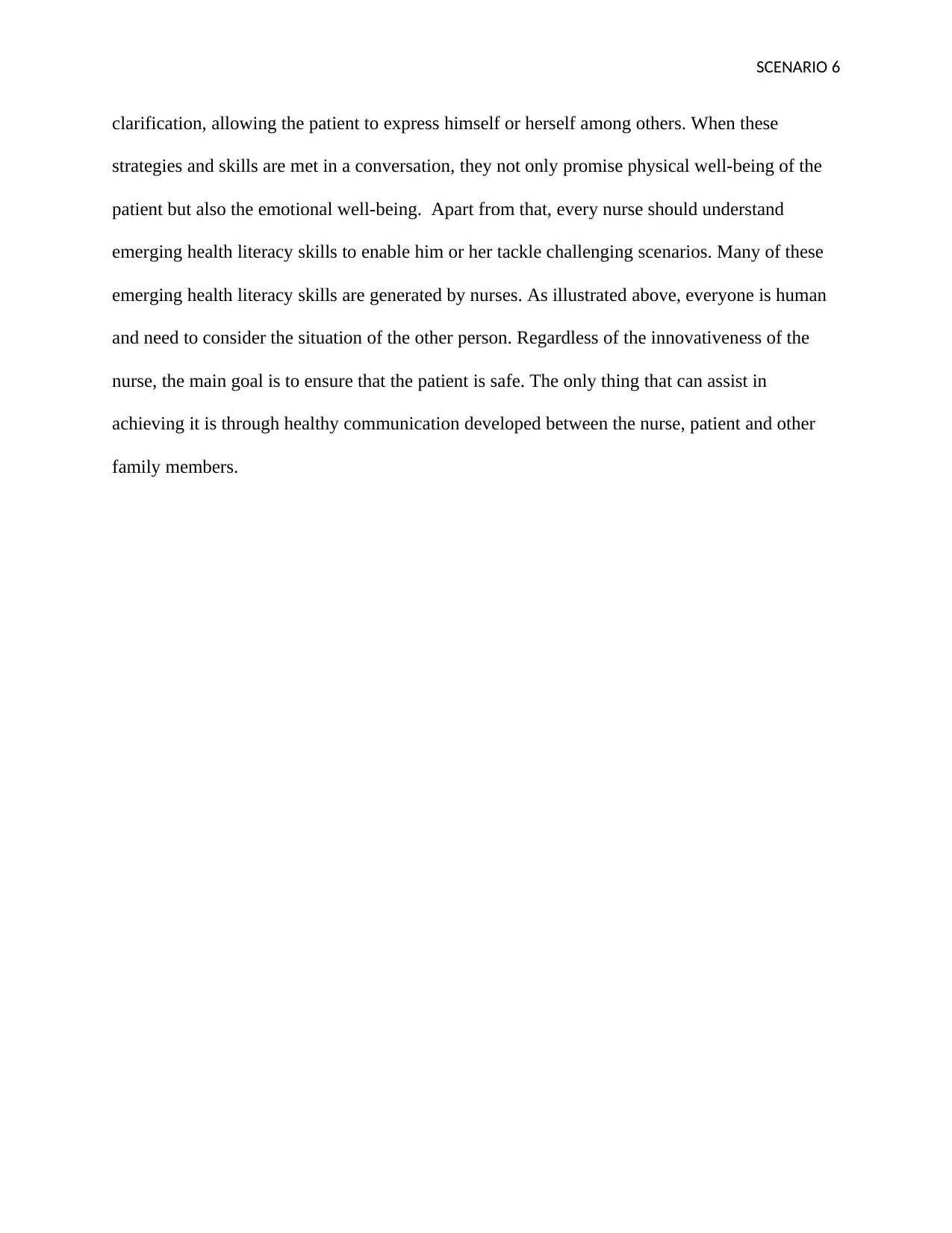
SCENARIO 6
clarification, allowing the patient to express himself or herself among others. When these
strategies and skills are met in a conversation, they not only promise physical well-being of the
patient but also the emotional well-being. Apart from that, every nurse should understand
emerging health literacy skills to enable him or her tackle challenging scenarios. Many of these
emerging health literacy skills are generated by nurses. As illustrated above, everyone is human
and need to consider the situation of the other person. Regardless of the innovativeness of the
nurse, the main goal is to ensure that the patient is safe. The only thing that can assist in
achieving it is through healthy communication developed between the nurse, patient and other
family members.
clarification, allowing the patient to express himself or herself among others. When these
strategies and skills are met in a conversation, they not only promise physical well-being of the
patient but also the emotional well-being. Apart from that, every nurse should understand
emerging health literacy skills to enable him or her tackle challenging scenarios. Many of these
emerging health literacy skills are generated by nurses. As illustrated above, everyone is human
and need to consider the situation of the other person. Regardless of the innovativeness of the
nurse, the main goal is to ensure that the patient is safe. The only thing that can assist in
achieving it is through healthy communication developed between the nurse, patient and other
family members.
⊘ This is a preview!⊘
Do you want full access?
Subscribe today to unlock all pages.

Trusted by 1+ million students worldwide
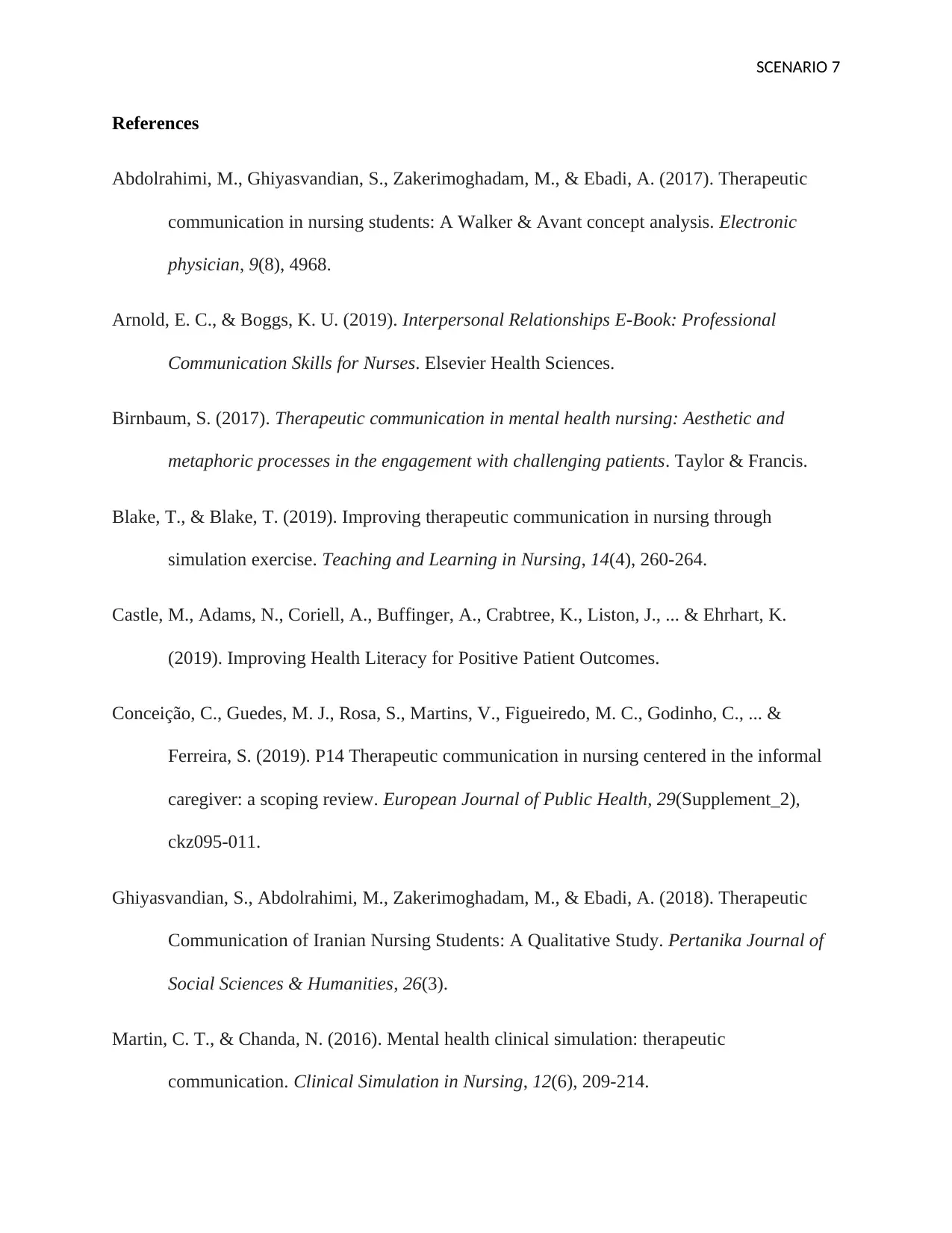
SCENARIO 7
References
Abdolrahimi, M., Ghiyasvandian, S., Zakerimoghadam, M., & Ebadi, A. (2017). Therapeutic
communication in nursing students: A Walker & Avant concept analysis. Electronic
physician, 9(8), 4968.
Arnold, E. C., & Boggs, K. U. (2019). Interpersonal Relationships E-Book: Professional
Communication Skills for Nurses. Elsevier Health Sciences.
Birnbaum, S. (2017). Therapeutic communication in mental health nursing: Aesthetic and
metaphoric processes in the engagement with challenging patients. Taylor & Francis.
Blake, T., & Blake, T. (2019). Improving therapeutic communication in nursing through
simulation exercise. Teaching and Learning in Nursing, 14(4), 260-264.
Castle, M., Adams, N., Coriell, A., Buffinger, A., Crabtree, K., Liston, J., ... & Ehrhart, K.
(2019). Improving Health Literacy for Positive Patient Outcomes.
Conceição, C., Guedes, M. J., Rosa, S., Martins, V., Figueiredo, M. C., Godinho, C., ... &
Ferreira, S. (2019). P14 Therapeutic communication in nursing centered in the informal
caregiver: a scoping review. European Journal of Public Health, 29(Supplement_2),
ckz095-011.
Ghiyasvandian, S., Abdolrahimi, M., Zakerimoghadam, M., & Ebadi, A. (2018). Therapeutic
Communication of Iranian Nursing Students: A Qualitative Study. Pertanika Journal of
Social Sciences & Humanities, 26(3).
Martin, C. T., & Chanda, N. (2016). Mental health clinical simulation: therapeutic
communication. Clinical Simulation in Nursing, 12(6), 209-214.
References
Abdolrahimi, M., Ghiyasvandian, S., Zakerimoghadam, M., & Ebadi, A. (2017). Therapeutic
communication in nursing students: A Walker & Avant concept analysis. Electronic
physician, 9(8), 4968.
Arnold, E. C., & Boggs, K. U. (2019). Interpersonal Relationships E-Book: Professional
Communication Skills for Nurses. Elsevier Health Sciences.
Birnbaum, S. (2017). Therapeutic communication in mental health nursing: Aesthetic and
metaphoric processes in the engagement with challenging patients. Taylor & Francis.
Blake, T., & Blake, T. (2019). Improving therapeutic communication in nursing through
simulation exercise. Teaching and Learning in Nursing, 14(4), 260-264.
Castle, M., Adams, N., Coriell, A., Buffinger, A., Crabtree, K., Liston, J., ... & Ehrhart, K.
(2019). Improving Health Literacy for Positive Patient Outcomes.
Conceição, C., Guedes, M. J., Rosa, S., Martins, V., Figueiredo, M. C., Godinho, C., ... &
Ferreira, S. (2019). P14 Therapeutic communication in nursing centered in the informal
caregiver: a scoping review. European Journal of Public Health, 29(Supplement_2),
ckz095-011.
Ghiyasvandian, S., Abdolrahimi, M., Zakerimoghadam, M., & Ebadi, A. (2018). Therapeutic
Communication of Iranian Nursing Students: A Qualitative Study. Pertanika Journal of
Social Sciences & Humanities, 26(3).
Martin, C. T., & Chanda, N. (2016). Mental health clinical simulation: therapeutic
communication. Clinical Simulation in Nursing, 12(6), 209-214.
Paraphrase This Document
Need a fresh take? Get an instant paraphrase of this document with our AI Paraphraser
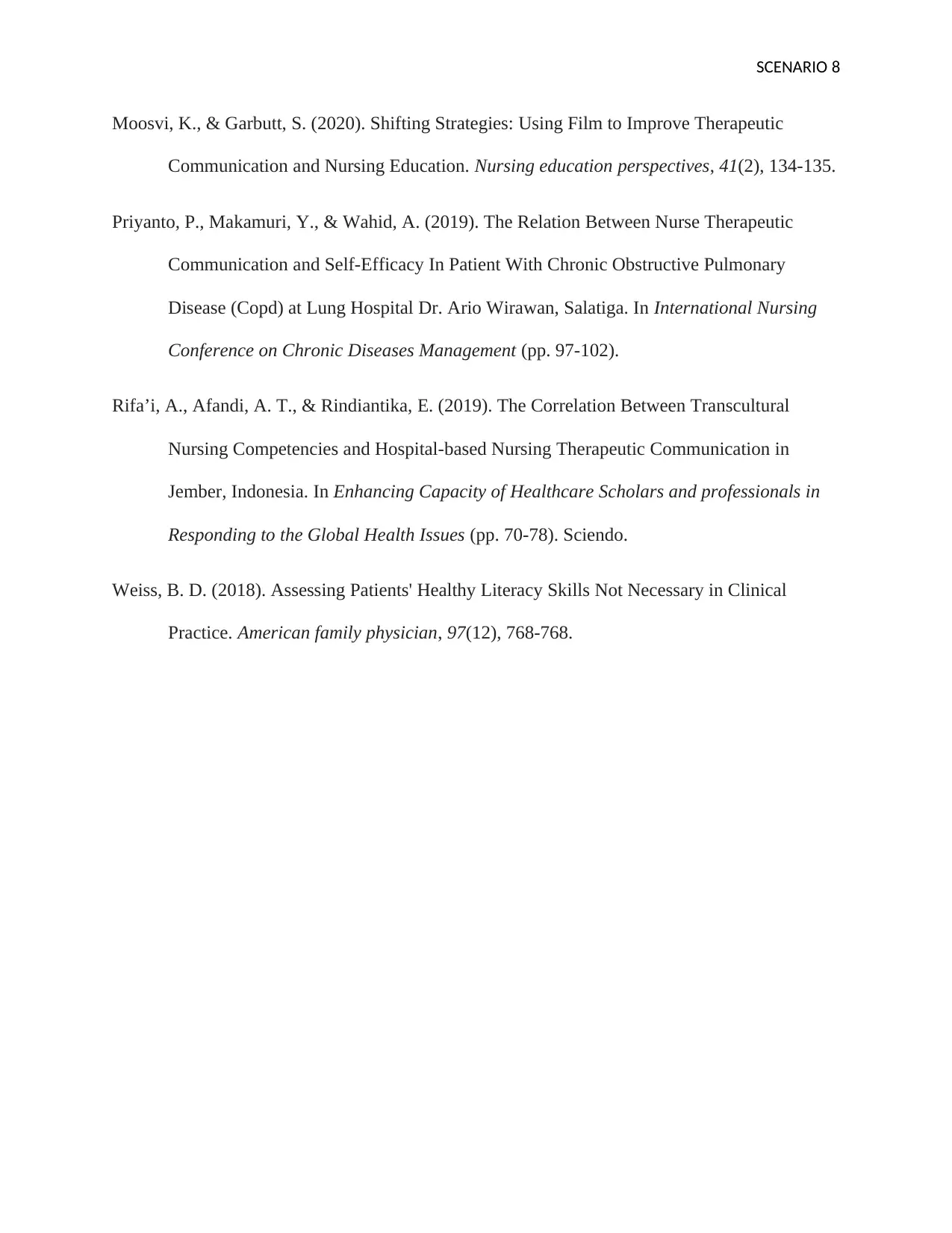
SCENARIO 8
Moosvi, K., & Garbutt, S. (2020). Shifting Strategies: Using Film to Improve Therapeutic
Communication and Nursing Education. Nursing education perspectives, 41(2), 134-135.
Priyanto, P., Makamuri, Y., & Wahid, A. (2019). The Relation Between Nurse Therapeutic
Communication and Self-Efficacy In Patient With Chronic Obstructive Pulmonary
Disease (Copd) at Lung Hospital Dr. Ario Wirawan, Salatiga. In International Nursing
Conference on Chronic Diseases Management (pp. 97-102).
Rifa’i, A., Afandi, A. T., & Rindiantika, E. (2019). The Correlation Between Transcultural
Nursing Competencies and Hospital-based Nursing Therapeutic Communication in
Jember, Indonesia. In Enhancing Capacity of Healthcare Scholars and professionals in
Responding to the Global Health Issues (pp. 70-78). Sciendo.
Weiss, B. D. (2018). Assessing Patients' Healthy Literacy Skills Not Necessary in Clinical
Practice. American family physician, 97(12), 768-768.
Moosvi, K., & Garbutt, S. (2020). Shifting Strategies: Using Film to Improve Therapeutic
Communication and Nursing Education. Nursing education perspectives, 41(2), 134-135.
Priyanto, P., Makamuri, Y., & Wahid, A. (2019). The Relation Between Nurse Therapeutic
Communication and Self-Efficacy In Patient With Chronic Obstructive Pulmonary
Disease (Copd) at Lung Hospital Dr. Ario Wirawan, Salatiga. In International Nursing
Conference on Chronic Diseases Management (pp. 97-102).
Rifa’i, A., Afandi, A. T., & Rindiantika, E. (2019). The Correlation Between Transcultural
Nursing Competencies and Hospital-based Nursing Therapeutic Communication in
Jember, Indonesia. In Enhancing Capacity of Healthcare Scholars and professionals in
Responding to the Global Health Issues (pp. 70-78). Sciendo.
Weiss, B. D. (2018). Assessing Patients' Healthy Literacy Skills Not Necessary in Clinical
Practice. American family physician, 97(12), 768-768.
1 out of 8
Related Documents
Your All-in-One AI-Powered Toolkit for Academic Success.
+13062052269
info@desklib.com
Available 24*7 on WhatsApp / Email
![[object Object]](/_next/static/media/star-bottom.7253800d.svg)
Unlock your academic potential
Copyright © 2020–2025 A2Z Services. All Rights Reserved. Developed and managed by ZUCOL.





